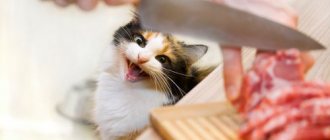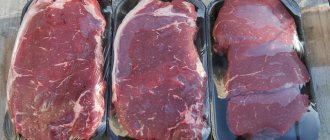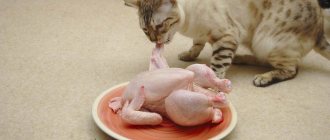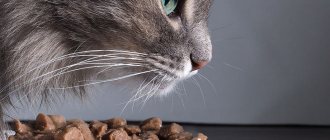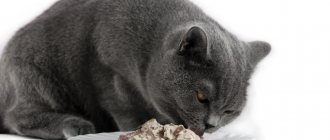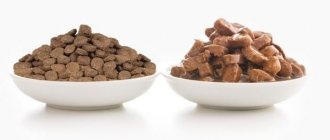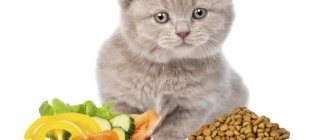Pet owners always try to pamper their pets, sometimes forgetting about the dangers of some products. It is known that cats love meat, some especially prefer pork. And they eat it in any form. In order for your pet to develop normally and grow healthy without causing trouble, you need to take a serious approach to choosing its diet. Particular attention should be paid to the choice of meat.
Arguments against pork
The most important and important argument is the fat content of pork. Per 100 grams of product there can be up to 30 grams of fat, which is dangerous for the pet’s health. Especially neutered cats are strictly contraindicated from eating it, as they lead a sedentary lifestyle and are prone to obesity.
This type of meat is poorly absorbed by the digestive system and can cause stomach diseases. Experts recommend giving animals lean beef, veal, turkey or chicken instead.
The composition of the product is not rich in vitamins and beneficial microelements. It contains little amino acids and protein, which are so necessary for the body. A positive and important quality of this type of meat is a large amount of vitamin B.
Fish
Arguments why you can’t feed a cat fish are divided into three main types: about dangerous fish bones, then about infection with helminths, and the last one is metabolic disorders. On the one hand, everything is reasonable, but on the other hand, many cats literally pounce on fish and eat it with pleasure due to a lack of protein.
- Avoid freshwater fish - there is little benefit, and the risk of helminth infection is high.
- Ocean fish contains fatty amino acids, but it is not recommended to give it often - 1-2 times a week.
- Feed only thoroughly cleaned and cooked fish.
- Use fish as an additive to your main feed.
- It is not recommended to feed a cat fish after castration; a large amount of phosphorus can provoke the development of urolithiasis.
The main dangers of pork
Taking this type of meat from private owners is strictly prohibited. Often people who raise livestock neglect sanitary standards and do not vaccinate their pigs. This leads to the spread of infection among the animal population, which leads to severe diseases that are difficult to cure.
After the cut meat is sent for sale to the buyer. It contains a lot of bacteria and parasites that cannot be seen at first glance. Often, unscrupulous people resort to deception: they tint a spoiled product to give it a marketable appearance, or soak it in a saline solution for several hours. The excellent appearance of a product does not mean its quality and safety.
Pork can be infected with Aujeszky's virus, which causes rabies in cats. To protect the animal from this, the product should be subjected to long-term heat treatment. Another dangerous disease is bulbar palsy, which is accompanied by severe symptoms. Raw meat often contains worms, so it is not recommended to give it to pets in this form.
Why is the raw product dangerous?
Cats digest raw meat best, but there are two dangers when consuming it:
- Worms. The meat may contain helminth eggs. These parasites poison the animal’s body, often damaging its internal organs, and if severely infested, lead to intestinal blockage. Without timely treatment, the cat may even die.
- Bacterial infections. If meat is sold from an open market stall, flies may land on it and carry the disease. Shopping in such places should be avoided so as not to harm your pet.
Harm and benefit for cats
Veterinarians do not recommend large quantities of pork for healthy animals. Elderly and castrated individuals are generally strictly prohibited from feeding it, since they lead a sedentary lifestyle and have a weakened immune system. Experts recommend limiting this product for pets with a predisposition to obesity.
But still, this type of meat has its positive qualities and can be beneficial. It contains vitamins from group B, the function of which is to improve metabolic processes and maintain the energy balance of the whole organism.
It also contains the following useful microelements: Potassium and Magnesium (they are necessary for the normal functioning of the cardiovascular system); Calcium and lysine strengthen bones; Iron carries oxygen to cells and tissues, and Zinc strengthens the body's immune system.
Which types to give preference to?
A cat's diet can be combined from several types of meat products:
- Lean beef. Contains a large amount of protein, moderate amount of fat, rich in taurine. It is believed that this meat brings the greatest benefit to the cat’s body. It can be given to your pet every day.
- Mutton. Only lean pieces. Can be given every day.
- Rabbit meat. Contains less protein and fat than beef. Recommended for cats that are overweight or have kidney failure.
- Turkey meat. Rich in protein and lean meat. It is advisable to alternate with beef.
- Chicken. Chicken meat is easily digestible, suitable for dietary nutrition, and contains a lot of protein. A number of experts, however, are wary of it because of modern methods of raising chickens (the use of hormonal supplements, antibiotics by producers, feeding salt before slaughter, etc.). Like turkey meat, you can give it from time to time.
- Fish. Only sea and boiled. No more than 200 g per week is allowed.
- Offal. The hearts can be chicken or turkey. Beef liver, lungs or tripe are preferred. By-products must be present in the diet, but not more than 200 g per week. Liver is given especially carefully: raw liver relaxes the intestines, and boiled liver strengthens it.
- Chicken necks without skin. They contain a lot of calcium, which other types of meat products are poor in. Some advise turning them through a meat grinder or beating them with a hammer, others recommend giving them whole. Focus on the capabilities of the pet itself: a kitten may not chew its neck, but a large cat can handle it easily. 3-4 raw shakes per week are allowed.
- Chicken heads. The most controversial product. The brain they contain is certainly beneficial for pets, but small bones, according to some veterinarians, can clog or injure the intestines. Other experts insist that chicken heads are essentially “mice” for cats, which these predators eat whole, and that the thin bones of the skull are easily digested. One way or another, no more than 2-3 goals per week are allowed. Please consult your veterinarian before adding this product to your pet's diet. Please also keep in mind that this is rough food, and it can really cause harm to a cat who has lived for years on soft, easily digestible food.
Now let's find out what types of meat should not be fed to cats, even in small quantities. These include:
- pork;
- fatty lamb;
- fatty poultry (geese and ducks);
- chicken skin;
- purchased minced meat (their composition may be far from what is stated);
- large and tubular bones - they injure and clog the esophagus;
- any fried, smoked and salted meat;
- canned food and sausages.
Some owners wonder why cats should not be given pork, such as lean parts of the carcass. The fact is that this meat often causes intestinal upset in pets.
Myths and facts about pork
There is still an opinion that this product is harmful to cats. But it is worth understanding this issue in detail. For the first time, nutritionists began to prohibit certain categories of people from eating pork. Afterwards, veterinarians agreed with their statement.
The first argument, that it causes indigestion and diarrhea, is not true. Boiled pork in small quantities will not cause any harm. The statement that this type of meat is considered the fattest is also questioned. Lamb contains the most fat.
Cats can be given chopped and boiled pork in small quantities. If there is a thick layer of fat on the piece, then it is necessary to cut it off with a knife. The main thing is to follow the diet and give the product in limited portions, then your pet will not have any health problems.
What to do before serving
There are three main ways to secure meat:
- Cooking. In this case, the meat is boiled for about 5 minutes.
- Scalding small pieces with boiling water.
- Deep freeze. The only way that allows you to leave the meat raw. To do this, cut it into pieces and place it in the freezer for 4–5 days (at least 48 hours). The helminth eggs die. The pieces do not need to be made too small: when a cat bites off and gnaws food, it simultaneously produces gastric juice. The meat is cut finely (about 1.5x1.5 cm) only for those animals that in a hurry swallow it almost whole.
Precautions when feeding pork to a cat
Before throwing a piece of pork to your beloved pet, there are some precautions you should take.
Remove all bones
Dogs love to chew bones, but they are dangerous for cats. If it gets into the throat, it can cause suffocation. This is why you need to carefully remove all bones from any piece of meat that is given to your cat.
Cook thoroughly
If you are going to feed your cat pork, it must be thoroughly cooked. The reason is simple - this meat is full of parasites that die during the cooking process. If this is not done, the parasites will enter the cat's body, which can cause it to get sick.
Pork is a source of dangerous diseases
Perhaps everyone knows that pigs often get sick and can be carriers of pathogens and parasites. This often discourages people from eating pork and pork by-products. But we must not forget that any animal living in unsanitary conditions, unvaccinated, and unkempt is also capable of getting sick. Usually such individuals are sent for slaughter and then for sale. It’s rare that any company processes such meat.
And although there is a special supervisory organization - veterinary control, there are still some nuances:
- There are still “workarounds” for obtaining the necessary documentation from veterinary control. This is especially true for small settlements.
- In a veterinary laboratory, meat products are not tested for viruses.
- Some infectious agents - viral, bacterial - die during heat treatment and are safe for people. For animals they can be very dangerous, for example, Aujeszky's virus. In order for such a pathogen to die, the meat must be boiled for at least a quarter of an hour in boiling water. Therefore, pork is given to cats only after thorough preparation.
- Pork, like all other meat and fish, is often contaminated with parasites. To become infected with helminthiasis, it is enough for one larva from raw meat to enter the body. Pork often turns out to be a source of trichinosis, and the main danger of the disease is the difficulty of diagnosis. Unfortunately, in most cases the parasite is detected when the pet can no longer be helped or after the death of the animal. The viability of the larvae depends on how long the pig has been infected. If it is dewormed, the larvae die during heat treatment. And if this procedure is neglected, then they begin to be encapsulated in muscle tissue, receiving protection from low and high temperatures. Therefore, we must not forget that trichinosis is dangerous for people, and without treatment it is fatal.
Pork is a rather specific product that causes a lot of controversy among nutritionists and veterinarians. But, if you choose it wisely, prepare it correctly and adhere to measures, then it can be included in the menu of your four-legged friend. However, when the owner doubts the quality of the product, it is better to refuse to use it.
Source
At what age are kittens given meat?
When should kittens be given meat for the first time? Complementary feeding begins at approximately 3-4 weeks. At this time, they still eat their mother's milk, but they are already trying adult food. The ideal option is to give the children the same thing as the mother if she is a raw foodist. If she eats industrial food, then the kittens are given a separate bowl of meat. Babies always need to start digestion, starting with raw meat.
The editors of the Murkotiki website often receive questions about problems with the gastrointestinal tract caused by improper complementary feeding. Many insufficiently competent breeders, unfortunately, give kittens porridge with boiled meat and immediately offer dry food. This almost always leads to small (unnoticed by the owner) or even big problems. Food can be added to the diet when the kitten already knows what meat is.
Balanced cat diet
It is better to buy any meat in a store, and not at the market from random sellers. In a specialized department, before sale, it is checked by sanitary and veterinary inspections, and is also properly stored and transported.
To prevent the formation of bacteria, it is worth defrosting the product in the microwave or refrigerator.
To provide a balanced diet for cats with pork, it is best to cook it. The process should not be long - no more than 5 minutes. It is also possible to bake in foil to prevent a crust from appearing.
But the main thing is to feed the animal in addition to meat products in a varied and balanced manner, including vegetables and fruits, so that the body does not experience a shortage of certain substances.
Many people have strong prejudices about the process of raising pigs and, in particular, the lifestyle of these animals. They say they love to wallow in the dirt and generally feed on food waste. So what? It turns out that this product simply has to absorb street dirt? Of course not. It's a delusion.
If, due to religious beliefs, you refrain from eating this type of meat product, then it would be logical if your pet does not eat such food either.
Pork is not a vital food for cats. If you want to treat your pet to meat, there is beef, lamb, chicken, etc. But remember: this type of food will be an excellent addition to your pet’s main diet. There are no contraindications.
General Safety Tips
You can't tell if your pork is infested with Trichinella or pork tapeworms just by looking at it because these larvae are microscopic in size. Therefore, the best protection against trichinosis is thorough cooking of pork.
Trichinella die at a temperature of 58°C, and tapeworm eggs and larvae die at a temperature of 50–65°C (5, 8, 9).
One study found that pork tapeworm eggs and larvae can be killed at a lower temperature of 50°C in roasts that bake for 15 to 20 minutes, but higher temperatures of over 65°C are required when cooking ground pork dishes (8, 9).
Experts recommend cooking pork until its internal temperature reaches 63°C when cooking chops, steaks and pork tenderloin. Cook ground pork, processed meats, or mixtures until an internal temperature reaches at least 71°C (10°F) (10).
Whether it's pork or minced meat, you should let the meat rest for 3 minutes before eating it. This allows the meat to continue to cook and raise the temperature.
When cooked to 63°C, you may notice that white meat has a pink tint when you cut into it. According to revised USDA guidelines, this is acceptable.
To measure the temperature of your meat you must use a calibrated thermometer and follow the manufacturer's recommendations.
Proper food processing is also very important. This means that hand washing is a must when preparing food, as is using clean drinking water to wash surfaces, utensils or utensils.
Conclusion:
Cooking pork to a safe temperature is essential to avoid contamination. Although pork tenderloin, chops and steaks should be cooked to 63°C, ground pork should reach at least 71°C. Let the meat rest for 3 minutes before eating.
Mixed nutrition
There are three types of diet for domestic cats:
- natural nutrition from ordinary products familiar to humans;
- feeding with ready-made industrial feed created for animals;
- mixed diet, which involves feeding cats natural products in combination with ready-made food.
Natural food and raw meat
When feeding natural food, the issue with raw meat is resolved on its own. This product is included in the pet menu. It can be served in processed form. To get a more nutritious meal, veterinarians recommend combining meat pieces with other healthy foods.
Dry, wet food and raw meat
Is it necessary to feed a cat raw meat if it regularly eats ready-made industrial food?
Many experts do not recommend combining ready-made food with natural food, believing that such a composition will only cause harm to the animal’s body. Others recognize the possibility of mixed nutrition, but on the condition that an interval of several hours is maintained between feeding food and natural food. During this time, the cat’s body will have time to digest the previously consumed product.
If your cat eats premium wet food, it is not necessary to add raw meat to the menu. High-quality feed contains natural meat, so there is no need for additional complementary feeding with this product.
Dry and canned industrial feed
Lots of salt and preservatives, but little benefit - the statement is quite fair if we are not talking about professional brands. Whisk**, Kitek**, Friski** and similar brands are exactly what should not be fed to sterilized cats, and it is not recommended for street animals. If your pet has a breed tendency to pathologies and you are forced to purchase industrial food, pay attention to the composition of the product, specifically the columns: protein and salt digestibility. For example, a low-salt diet is recommended for Persian cats; for a Siamese cat, the high energy value of food is extremely important.
Types of “safe” meat for cats
More than 80% of a cat's daily diet is meat. But, before feeding your mustachioed pet this product, you need to figure out which types of meat will be beneficial for the cat’s health and which types of this product can cause serious harm to the body.
First of all, you should focus on the following rules:
- the meat must be fresh;
- low-fat;
- without small and dangerous bones;
- no unpleasant odor.
You need to feed your cat high-quality meat, and not waste product that is not useful on the human table. From time to time, your pet can be pampered with offal and cartilage, always fresh and low-fat (no more than 200g per week).
To feed your cat, you can buy chicken, quail, lean lamb, beef, rabbit, turkey, horse, goat and beef.
Pork, duck, goose and fatty lamb are prohibited.
Now let's figure out in what form meat can be served to a domestic cat.
Grilled meat
Fried product is strictly prohibited for feeding domestic cats. After eating such meat, the animal may experience serious problems with the liver, stomach and other organs of the digestive tract. All this will lead to a lot of unpleasant health problems for the pet and will significantly shorten its lifespan.
Cooked meat
This meat can be given to a cat. It contains many nutrients that are beneficial for her body. The main thing is to cook the meat correctly: boil it in low-fat broth without salt and other spices.
And one more rule: you cannot give raw and cooked meat at the same time.
To digest these foods, the body will need to produce different enzymes, which will negatively affect the digestion process. This may manifest itself as vomiting, stool disturbances and other unfavorable symptoms.
Smoked meat
Smoked meat is very dangerous for the body of a small predator. It is unacceptable to feed your pet such a harmful product!
Raw meat
Raw meat is a natural food for domestic carnivores. In their natural environment, cats always feed on prey consisting of small rodents and birds. It’s clear that they consume their catch raw, without cooking.
It is necessary to give your cat raw meat, but this product must first be frozen and scalded with boiling water shortly before serving to the animal. This precaution will reduce the likelihood of helminth infection.
To create a complete diet for a mustachioed pet, experts recommend combining meat with other healthy foods. For example, you can serve it with vegetable puree and olive oil. Or prepare a delicious soup from low-fat broth with herbs, butter and pieces of meat.
- fresh meat should be cut into pieces, distributed into bags in small quantities for one feeding and sent to the freezer for freezing;
- Meat should be frozen for 3-4 days or more;
- extreme cold destroys helminth eggs, which makes the meat product absolutely safe to feed cats;
- Before serving, the meat can be slightly warmed in the microwave or poured boiling water over it;
- It is better to defrost the product in a plate; after defrosting, juice from the meat will remain in it, which your furry friend will also happily sip on;
- Sometimes you can pamper your cat with raw minced meat, prepared yourself from fresh lean meat, without salt and spices.
Breed exceptions
What cereals can be given to dogs: is it possible to give porridge?
Can a Spitz eat pork? The answer to such a question will be negative. For small dogs such as Chihuahuas, Spitz, and Toy Terriers, fatty foods are contraindicated. In particular, due to the fact that these breeds are prone to obesity.
As for larger dogs, such as a shepherd, husky, or alabai, a small amount of pork in the diet will not cause harm. However, under no circumstances should you feed your animal raw meat.
Everything is good in moderation
What parts of pork carcass can be included in the diet?
The owner who decides to give his pet pork should know that the diet can include:
- ham meat;
- tails;
- snouts.
Pork heart for dogs is also an acceptable option. As for bones, they should be given out with great care. Ribs are not recommended for small breeds.
Another important question: is it possible to give lard or skin to a dog? In this case, there are no prohibitions, but it is best to limit yourself to the smallest amount. The skin is not a nutritious product, and lard is high in calories and has a minimal set of beneficial properties.
Can dogs have boiled pork?
For healthy animals, this type of boiled meat is not contraindicated. Especially if the meat component is pre-mixed with boiled potatoes or porridge. In this case, you will get a nutritious and healthy dish.
On the other hand, you should refrain from adding boiled meat to the diet or do it with extreme caution if your pet suffers from liver disease, spleen disease, tumors or hepatitis. It is worth noting that such ailments, in principle, require adherence to a strict diet, which does not include pork.
